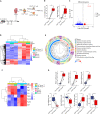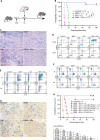Combinations of anti-GITR antibody and CD28 superagonist induce permanent allograft acceptance by generating type 1 regulatory T cells
- PMID: 35921418
- PMCID: PMC9348800
- DOI: 10.1126/sciadv.abo4413
Combinations of anti-GITR antibody and CD28 superagonist induce permanent allograft acceptance by generating type 1 regulatory T cells
Abstract
Type 1 regulatory T (Tr1) cells represent a subset of IL-10-producing CD4+Foxp3- T cells and play key roles in promoting transplant tolerance. However, no effective pharmacological approaches have been able to induce Tr1 cells in vivo. We herein report the combined use of a CD28 superagonist (D665) and anti-glucocorticoid-induced tumor necrosis factor receptor-related protein monoclonal antibody (G3c) to induce Tr1 cells in vivo. Large amounts of IL-10/interferon-γ-co-producing CD4+Foxp3- Tr1 cells were generated by D665-G3c sequential treatment in mice. Mechanistic studies suggested that D665-G3c induced Tr1 cells via transcription factors Prdm1 and Maf. G3c contributed to Tr1 cell generation via the activation of mitogen-activated protein kinase-signal transducer and activator of transcription 3 signaling. Tr1 cells suppressed dendritic cell maturation and T cell responses and mediated permanent allograft acceptance in fully major histocompatibility complex-mismatched mice in an IL-10-dependent manner. In vivo Tr1 cell induction is a promising strategy for achieving transplant tolerance.
Figures







References
-
- Leventhal J. R., Mathew J. M., Outstanding questions in transplantation: Tolerance. Am. J. Transplant 20, 348–354 (2020). - PubMed
-
- Roncarolo M. G., Gregori S., Bacchetta R., Battaglia M., Gagliani N., The biology of T regulatory type 1 cells and their therapeutic application in immune-mediated diseases. Immunity 49, 1004–1019 (2018). - PubMed
-
- Evans E. J., Esnouf R. M., Manso-Sancho R., Gilbert R. J. C., James J. R., Yu C., Fennelly J. A., Vowles C., Hanke T., Walse B., Hünig T., Sørensen P., Stuart D. I., Davis S. J., Crystal structure of a soluble CD28-Fab complex. Nat. Immunol. 6, 271–279 (2005). - PubMed
LinkOut - more resources
Full Text Sources
Research Materials

